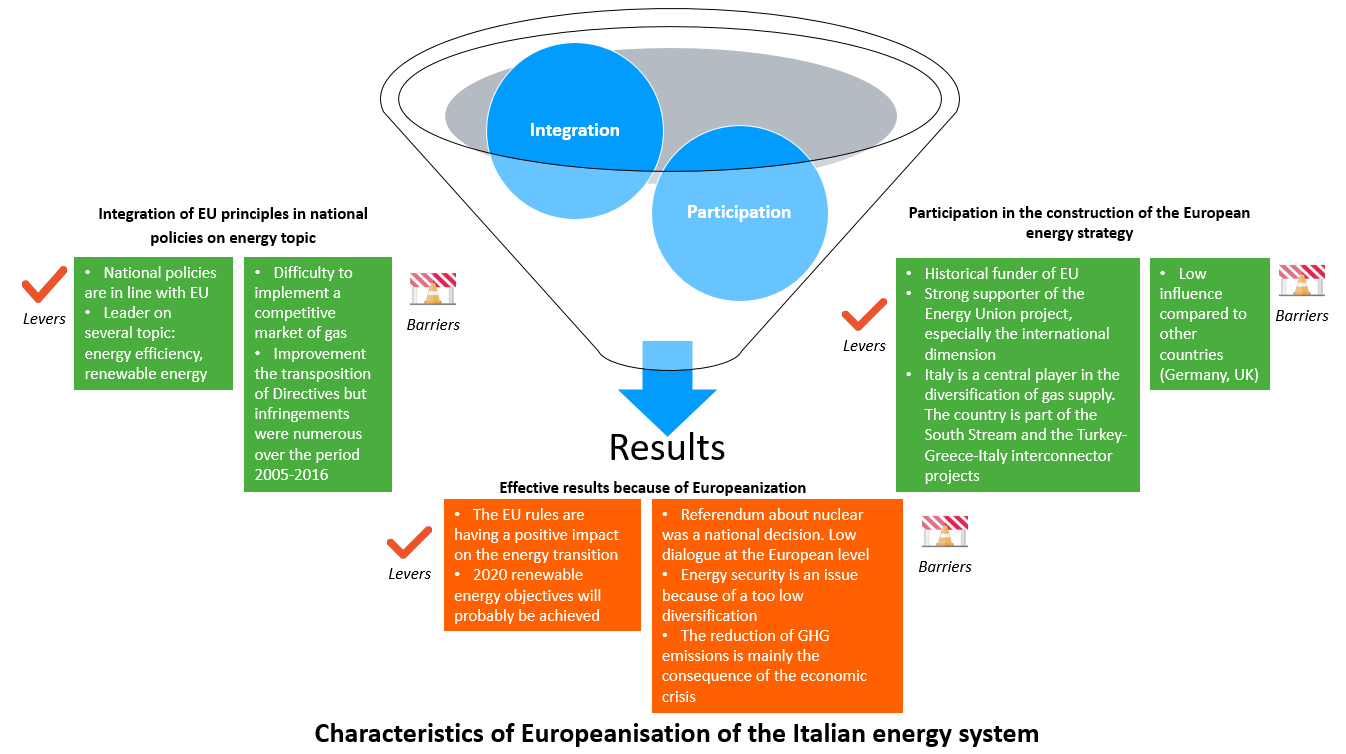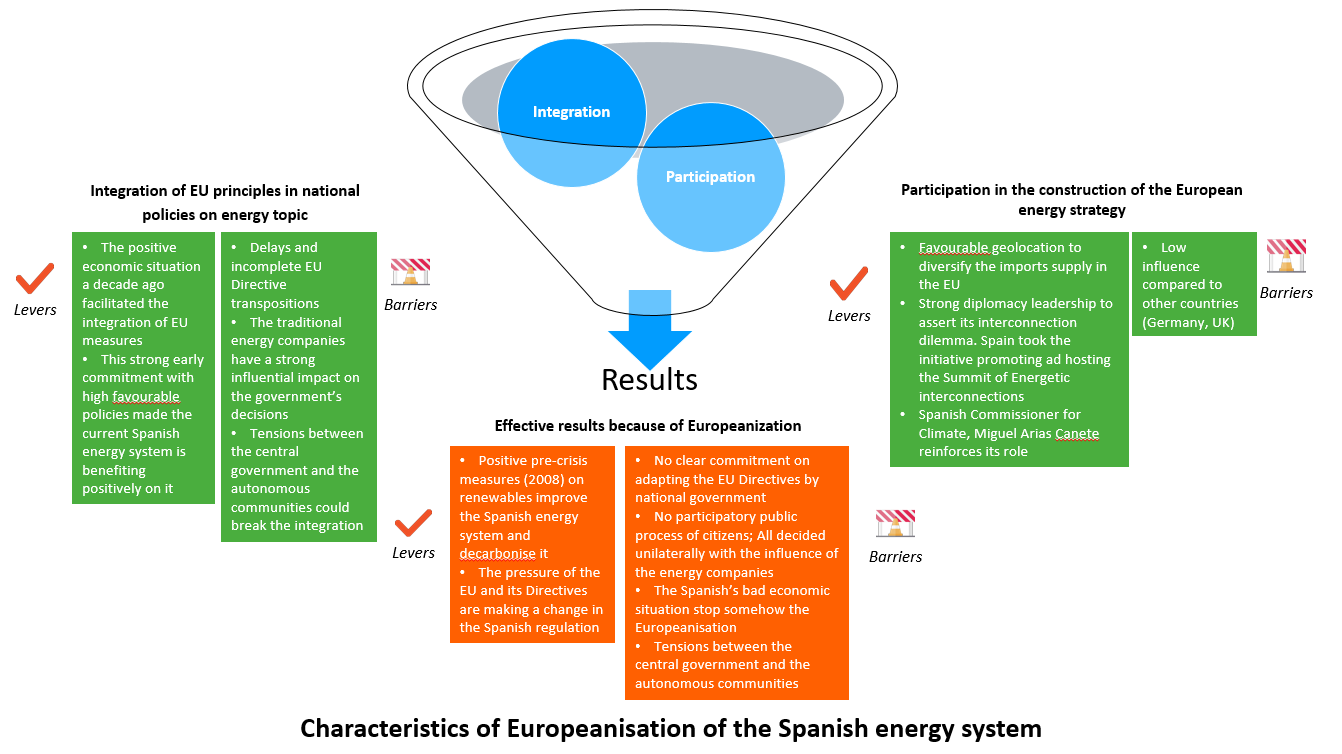Characteristics of Europeanisation of the French energy system
France has been an active player in the process of Europeanisation being involved in top down and bottom up approaches. In the top-down side, the French energy system integrates almost all dimensions of European energy policy, as per its accordance to the European energy frameworks or its adherence to the Energy Union project.

Nonetheless, the analysis reflects the appearance of a few bottom-up cases that have enable France to assert its interests in the European energy project. Its long standing participation in the creation of the EU and its economic power – as 2nd economy in the EU - might have conferred France with political power to influence the process. The French energy transition and its active role during the COP21 conferences have put France at the centre of the table in the European energy dialogue.
Characteristics of Europeanisation of the German energy system
Germany has been an active player in the Europeanisation processes. Its economic power and its political leading position in the EU confer the country an exceptional position to orientate European entities decisions. The high capacity of shaping of the Energy Union by German representatives (Zednik, 2016) or its influence in the promotion of renewable energies – Germany has developed different Renewable Energy Acts since 2000 - illustrates perfectly well this situation. The country possesses a strong influential power whether it is reflected in the European power game or via bottom-up Europeanisation. Indeed, the term Germanisation has been used in literature as the spread of German energy policies at extra national level, which could elevate the tension on the energy topic at EU level.

The country integrates, sometimes reluctantly, all the dimensions of the European energy strategy. However, Europeanisation is not the most powerful driver of the transformation of the German energy system, as the German interest prevails. The two main pillars of the German energy transition, the nuclear phase out and the focus on renewable energy, were decided without considering Europe or other MS.
It is also worthy to point out the citizen involvement in the German energy system. They are prosumers - rather than only consumers - active through the energy cooperatives.
Characteristics of Europeanisation of the Irish energy system
Ireland is involved in the Europeanisation mechanism process though its level of influence is probably lower compared to the other MS analysed in this study. The high energy dependence associated with the peripheral location of the country but especially the economic and political crisis that occurred between 2008 and 2011 reduced its room for manoeuvre. Ireland was on an energy and economical drip from EU even if the county has since initiated a regrowth and an energy transition. It contributes to depict Ireland as a follower which undergoes a top-down Europeanisation process. Its energy policy is inextricably tied to the European energy strategy even if it capacity to transpose Directives correctly remains a challenge so far. The Brexit could be a real game changer for Ireland which could take the opportunity to assert itself as a European regional leader.

Although Italy is subject to a top-down Europeanisation integrating the European vision, some energy decisions are taken regarding national factors. For instance, the renouncement to nuclear energy was related to the Chernobyl disaster. An additional example concerns the possible achievement of the 2020 GHG reduction objective which is mainly due to the economic crisis. This top down Europeanisation is also slow down by issues to transpose effectively EU directives.
Although the Italian contribution is less pronounced than other MS, the country participates in the construction of the European energy strategy in order to assert its interests. The Italian focus on the international dimension of the Energy Union is very likely linked to its energy security issues. It could be interpreted as a pace-setting form of bottom-up Europeanisation. Establish new partnerships for gas supply could be as the core as its strategy. As an illustration it is possible to mention the country’s involvement in two major gas pipelines.
Characteristics of Europeanisation of the Italian energy system
Italy seems to integrate slightly well the dimension of the European energy strategy. For instance, Italy is on right track to reach its 2020 renewable energy objective. The European energy vision has constituted a guiding principle in the shaping of the national PLS.

Characteristics of Europeanisation of the Spanish energy system
Spain hardly succeeded to assert its interests at European level within the power game. Its influential power is low compared to other MS such as Germany, UK and France, having more impact on the shaping of the Directives. Nonetheless, in some occasions the country proceeds through bottom-up mechanisms to assert its interests. The diplomatic strategy setup by the country to increase its interconnection with France illustrates the Spanish approach towards Europeanisation. Spain could be considered as a follower.

The economic crisis that hit the country shattered the integration of EU measures. It prevented the good transposition of energetic and environmental Directives, as the economical dimension is still today the priority. The ‘Sun tax’ is a perfect example of this priorisation that diverts the investment in the renewable energy sector (Walsh, 2015).
The recent good signs from the Spanish economic as well as the resurgence of influence at the European level illustrated by the central role of Miguel Arias Canete could be a game changer.
Characteristics of Europeanisation of the Britain energy system
UK has been actively involved in the Europeanisation process over the last decade. Even backward, UK has respected the legitimacy of the European Commission and attempted to use its influential power to assert its interests. The country always pledge for flexibility and emancipation within the European project. Reinforcing its position of leader, it proceeded to pace-setting bottom-up Europeanisation to promote climate change policy. UK enjoys a leading position in the Europeanisation process. But contrary to Germany which uses its power to shape an EU energy project modelled on its interests, UK tries on the top of that to limit the influence from the European Commission.

The Brexit and its consequences will bring about major changes in the relation between UK and EU institutions. UK may opt for a collaboration strategy modelled on the Norwegian case. Otherwise, the country may content itself with bilateral agreements. Only time will tell. Nonetheless the Brexit does not mean that the national energy decisions will not be tinged with some European energy logics insofar both UK and EU share common challenges.

